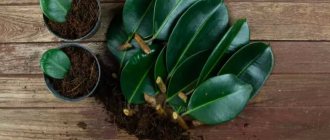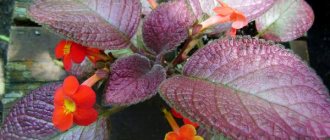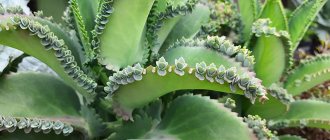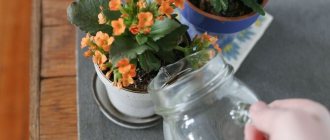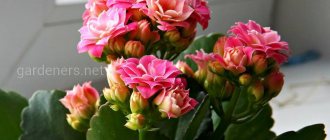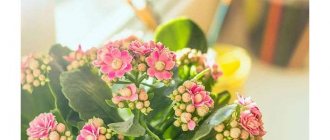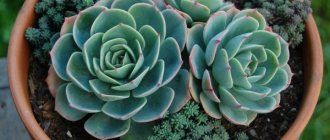- August 20, 2018
- Houseplants
- Alexander Nedashkovsky
Today, flower growers grow a wide variety of Kalanchoe varieties at home. The ornamental plant has medicinal properties. In addition, it has a beautiful appearance. Reproduction of Kalanchoe is not difficult even for inexperienced gardeners. This is probably why the plant is so common in our apartments.
Plant varieties
Throughout history, Kalanchoe has received many names - room doctor, tree of life, home healer... Our grandmothers always had this plant on their windows. Currently, there are many different species of this beautiful flower, including flowering representatives. They are the ones who are most popular. In nature, there are a total of more than 200 varieties of Kalanchoe. Only a few of them are grown at home. All of them are easy to care for and reproduce.
Kalanchoe can safely be classified as an unpretentious flower. The plants belong to the Crassulaceae family. Its homeland is the tropics, so the flowers are accustomed to long stays in wet and dry conditions. At favorable times, the leaves of the plant accumulate moisture, which they gradually use for survival. The flower takes root well in any home and does not require frequent replanting or fertilizing, which makes caring for it much easier. The plant is very resistant to pests and diseases. Even if you did something wrong and your flower began to die, you can always divide it into cuttings, which take root very easily. Reproduction of Kalanchoe is a simple process. Almost every rooted plant turns into a healthy and full-fledged flower.
Peculiarities of reproduction of Kalanchoe of different species
When does Kalanchoe bloom - how often at home
Before you start breeding Kalanchoe, you need to take into account the fact that some species have their own characteristics in carrying out the reproduction process:
- Degremona. Cirrus and tubeflowers reproduce well by children;
- Kalanchoe Kalandiva is suitable for propagation by cuttings. This is the best way for Magnin and Blossfeld;
- All types of plants that have a fleshy green mass are propagated by petal cuttings;
- division by offspring is suitable only for Blossfeld;
- paniculata species of Kalanchoe are best propagated by buds;
- The seed type of propagation is used for feathery and tomentose types of flowers.
Medicinal properties
People have long been aware of the medicinal properties of Kalanchoe. It is for this reason that previously it could be found in any home. Not only the leaves, but also the stems are used for medicinal purposes. Kalanchoe is one of the few plants that purify indoor air and destroy germs, disinfecting the room. The flower copes well with the flu virus. If now we are accustomed to using pharmaceutical products for colds and runny noses, then previously Kalanchoe was considered the first assistant. You can use it to make cold drops. The juice of the plant is also useful for wiping the nasal mucosa.
Kalanchoe has a powerful anti-inflammatory effect. It has antibacterial, hemostatic and bactericidal properties. The plant copes well with wound healing, it removes harmful substances from the body and cleanses the blood.
The medicinal properties of the flower are based on the fact that it gives a surge of strength and vigor. It is believed that the presence of Kalanchoe in the house contributes to a friendly and favorable environment.
The medicinal properties of Kalanchoe are actively used in folk medicine. The leaves are mainly used, from which juice or pulp is obtained. The plant contains a large number of biologically active and healing substances, among them it is worth highlighting organic acids, flavonoids, tannins, mineral salts, vitamins, macro- and microelements. Kalanchoe juice is used for herpes, to boost immunity, and for physical fatigue. The plant is rich in vitamin C, and therefore is indispensable for vitamin deficiency. Kalanchoe juice is used as ear drops to treat warts, trophic ulcers, purulent wounds, and burns. For sore throat, dilute it with water and gargle with the resulting solution.
Characteristics and cultivation
This type of Kalanchoe is one of the domestic plants that has not only an aesthetic component, but also medicinal properties. Kalanchoe blossfeldiana is considered to be native to tropical Madagascar. Despite this, the flower does not require special care, making it very easy to grow at home.
A houseplant such as Kalanchoe Blossfeld is quite undemanding to care for at home. But its appearance, growth rate and flowering are directly proportional to where the flower is located in the house. Therefore, you need to choose the right place for him. To do this, you need to familiarize yourself with some features:
- in lighting;
- in temperature conditions;
- in air humidity;
- in soil requirements.
Lighting requirements in the room
This succulent is one of those plants that require sunlight on a constant basis, but there are some peculiarities in lighting:
- From morning until lunch, the flower must be placed on the windowsill in direct sunlight so that the petals are fully saturated with light.
- In the afternoon it must be moved into the shade to create “night” for the plant. After lunch, the petals and leaves simply stop receiving sunlight, which can cause harm.
This lighting mode is required for this type of flower. Otherwise, they will stop blooming and may even wither. If it is not possible to constantly move the Kalanchoe from place to place, you can simply cover it with a scarf after lunch.
Temperature and humidity
As a rule, this plant is very resistant and unpretentious to the temperature in the room .
It will be comfortable both at +5 C and at +25 C. However, if Kalanchoe is kept at a high temperature for a long time, it can quickly dry out and die. If the room is very hot for a long time, it is necessary to increase the frequency and volume of watering or move it to another room (if it is cooler). Excessively high air humidity in the room can be detrimental to the flower. After all, it absorbs all the moisture and accumulates it in the stem, and not in the root, like some other plants. Because of this, the flower may begin to rot, and mold or mildew may appear. Therefore, it is better to choose a room with low humidity and without drafts.
Soil for a flower
The soil for this indoor plant must be multi-component, nutritious and fertilized. It should also pass and release moisture well. Therefore, it will be better if you prepare your own substrate for Kalanchoe Blossfeld. Its composition in a one to one proportion should include the following components:
- Peat;
- Sand (preferably river);
- Humus;
- Turf or leaf soil.
Some experts recommend adding charcoal to the soil, but this is not necessary. It is also necessary to make a drainage layer in the pot from expanded clay, crushed stone and crushed bricks.
Lighting
One of the most unpretentious indoor plants is Kalanchoe. Care after purchasing a flower is so simple that even a novice amateur gardener can handle it. The plant can be placed almost anywhere in your home as it thrives in indirect light and partial shade. You can also place the flower in direct sunlight. But at the same time, its leaves will change color slightly. Ideally, you should choose western or eastern windows, where the lighting is moderate.
For flowering species, the south-eastern and eastern direction is more suitable. In winter, the plant will need additional lighting. If a flower does not have enough light, it stretches and weakens. The upper leaves may turn pale and the lower leaves may die.
First care after the procedure
In order for the propagated plant to take root and grow as quickly as possible, it is recommended to follow the rules of caring for it:
- do not allow the room temperature to drop below +8 degrees;
- water once a month, spray periodically;
- provide bright lighting, but in no case direct sunlight;
- regularly ventilate the room, but avoid drafts and exposure to cold air;
- constantly feed the plant with special fertilizers;
- inspect the plant for the presence of diseases and pests, and promptly deal with them if detected.
The process of propagating indoor Kalanchoe is a simple and easy process that can be enjoyable. Compliance with all the above rules will help to properly propagate the plant, provide it with simple acclimatization and grow it healthy and beautiful.
Watering Kalanchoe
Very often, beginners do not know how to properly water Kalanchoe. The plant accumulates liquid in the foliage. Therefore, he is not afraid of a period of drought. For example, the plant will not dry out if you leave for a while. But overwatering has a detrimental effect on the flower. In this case, it is not the amount of water that plays the main role, but another factor. When watering, the earthen ball must be well moistened. But later the excess water must be drained. In order not to overdo it with watering, it is worth developing the correct regime. To do this, it is necessary to moisten the soil after it has completely dried in the pot. Water procedures can be performed more frequently only in the summer heat. In winter, on the contrary, it is necessary to water the plant no more than once every 10-14 days. If the soil moisture is excessive, its roots will begin to rot. In addition, excessive humidity promotes the development of fungal diseases and mold.
In principle, Kalanchoe does not need to be sprayed. In winter, high humidity is dangerous for the plant. But at the same time, the flower periodically needs to be rid of dust accumulated on the foliage. To do this, you can bathe Kalanchoe in the shower or wipe the leaves with a damp sponge.
Proper pruning
For some plant varieties, pruning is an essential part of care. This is especially true for flowering species. How to prune Kalanchoe? The pruning procedure must be drastic. The flower stalks are cut off completely, leaving no extra parts. Very often, flowering greatly weakens the plant. In this case, you will have to cut off all the bad looking and old parts of the flower. At the same time, young and strong shoots can be cut off and used for propagation of Kalanchoe. In summer, flower growers recommend pinching off the top so that new side shoots appear. If this is not done, the plant will stretch.
How to prune a Kalanchoe that does not bloom? Even non-flowering forms require periodic pruning. The plant usually grows in height quickly. A too huge flower clutters up the space, so it is necessary to cut off some of the branches and the crown so that the bush grows wider. The resulting cuttings can be used for rooting. Pruning allows you to rejuvenate the plant. Young bushes look more aesthetically pleasing and beautiful.
Different methods of reproduction
Kalanchoe is a plant that reproduces very easily. You can get new flowers in a variety of ways. The process of flower propagation is so simple that anyone can handle it. Plant propagation is carried out by children, seeds, stem and leaf cuttings, and offspring. Any method always gives good results. To propagate Kalanchoe by leaf, you can even use fallen old leaves, which take root incredibly easily.
Some varieties of the plant reproduce by children. Small daughter sprouts form on the leaves of Kalanchoe. Children look very much like adult plants. They have small leaves and roots. Adult succulents most often shed such buds themselves, which easily take root in the mother pot. Later they can be transplanted into another container. If you find formed shoots on the leaves, you can safely break them off and plant them in fertile soil.
Propagation by leaves can be carried out at any time of the year. A cut adult leaf is planted in a pot with a moist substrate. It is covered with a jar or glass on top. The leaf takes root in just a few days. Soon it will become an independent plant. Sometimes part of a leaf is used for propagation. It is buried in the ground and after some time a young plant develops from it.
How to propagate: step-by-step instructions
Let's look at how to properly propagate this indoor flower using various methods.
Cuttings
Cuttings are a universal method of plant propagation, so flower growers in most cases resort to it. In this case, cuttings that remain after pruning or transplanting are used. But if necessary, you can cut the stem at any time. One of the main conditions is that the length of the branch must be at least eight centimeters.
Propagation by cuttings occurs as follows:
- The cutting is cut, the leaves near the cut are removed. The branch is left at room temperature for two to three hours so that the cut area dries out.
- It is not at all necessary to plant the cuttings right away; you can leave it in water until roots appear.
- It is recommended to plant the twig in a small pot made of clay or plastic.
- The container with the cutting is placed in a well-lit place (but without direct sunlight) at an air temperature above plus twenty degrees Celsius. Within a month, the root system begins to grow.
How to propagate Kalanchoe from cuttings is described in this video:
Leaf
This method can be used to propagate any type of Kalanchoe with dense, fleshy leaves. In addition, even flowering plants can be propagated by leaves. To do this you need:
- Carefully cut the leaves from the bush and plant them in a pot with moist soil. The cut area needs to be dried a little before planting.
- The leaf can be planted vertically, or horizontally, sprinkled with earth from the cut side. A mixture of sand, peat, and humus is suitable as a substrate. In addition, you can buy special soil in the store and mix it with river sand.
- A small glass jar is placed on top of the leaf, and the pot is placed in a lighted place.
In addition, leaves that have fallen from the plant can be used for propagation, as long as they are undamaged. It is best to first place them in water until the roots appear, but they can be planted in the ground immediately.
Only healthy leaves without any damage or dried parts should be used for propagation.
From the video you will learn how to propagate Kalanchoe with leaves:
Seeds
Felt and feathery Kalanchoe are best propagated by seeds. This option is suitable for breeding a large number of new plants.
- Preparing the container and soil for sowing. The substrate should be used with the addition of sand, and it is better to choose a wide, rectangular container.
- A layer of drainage is poured onto the bottom, and soil is placed on top, which should be moistened with a spray bottle.
- Seeds are placed on the surface of the soil in several rows, the distance between which should be approximately 5 cm. The distance between the seeds should be 10 mm.
- After the seeds are sown, they need to be slightly pressed into the soil with your hands or using a spoon. However, they cannot be completely immersed in the soil.
- The container is covered with film or transparent glass and placed in a lighted, warm place with a temperature of at least plus 20 degrees.
Before the first shoots appear, the container must be regularly ventilated and ensure that moisture does not collect on the glass or film. Periodically, the seeds are sprayed with warm water. After a week, you will be able to notice the first shoots. After this, you can remove the glass (film), and after a couple of weeks, plant them in different pots.
Children
Only pinnate and tube-flowered Kalanchoe, as well as Degremona, can be propagated through brood buds. Babies appear on the leaves of the bush and are small plants with roots. In adult bushes, after formation, the buds separate under the weight of their own weight and can take root next to the Kalanchoe. After they grow, you can start replanting them in different pots.
If necessary, the children can be separated from the bush independently and planted in a separate container.
Offspring
Only one species can be propagated in this way - Kalanchoe Blossfeld. Offshoots often begin to grow after pruning the plant next to the bush itself. It is recommended to separate them only after they have grown to one third of the “parent” flower. They are then placed in different pots where they begin to grow.
Axillary buds
Some species of this indoor plant begin to shed their leaves after flowering. In its place you can see small buds. In this case, propagating the plant is quite easy:
- Wait until the buds grow to two centimeters in length.
- Cut and plant in a pot with a suitable substrate.
How does a flowering plant reproduce?
Kalanchoe can only bloom once a year. It is permissible to propagate it during this period only by leaves.
Healthy material is used. In addition, the plant needs to be provided with a high temperature of +18-24 degrees and bright, diffused lighting.
How to root?
It is necessary to root cuttings or leaves in a prepared, pre-moistened substrate. The ideal option is if the soil is half mixed with river sand. You can first place the shoots in a glass or other container with water and wait for the roots to appear.
Propagation by cuttings
The simplest and most popular way to propagate Kalanchoe is by cuttings. It is relevant at any time of the year. For planting, you can use any twig that accidentally breaks off from the plant. This often happens during the process of flower transplantation. It is necessary to choose strong shoots as cuttings. They can be of any length, but it is worth shortening them to 6-8 centimeters. Typically, the tops of shoots are used for propagation.
They are cut and placed in a jar of water until roots appear, after which the young plants are planted in separate pots. Shoots can also be immediately planted in a moist substrate. They quickly take root in the nutrient mixture. The apical cuttings produce beautiful young plants.
Reproduction by children
In Kalanchoe pinnate and Kalanchoe Degremona, there are brood buds at the edges of the leaves, from which many young plants with roots are formed.
As they grow, they break away from the leaf, fall to the ground and take root on their own. This can happen at any time of the year. For rooting, only the children with roots need to be separated from the leaf . They are planted in a container with soil at a distance of at least 2 cm from each other. The soil for planting children should be fertile and very light. For this purpose, it is best to use a purchased light soil mixture with the addition of peat.
When planting, you should not bury small children too deeply; their leaves should be on the surface. Water the container with seedlings moderately. The children quickly take root and begin to grow. Over time, they are planted in separate pots.
Other methods of reproduction
Sometimes Kalanchoe is propagated by offspring of the mother plant. To stimulate the process, it is necessary to pinch the tops of the stems, after which young shoots appear next to the old flower. This method can be used only after flowering. After the young plants have grown a little, they can be transplanted into another pot.
Some varieties of the flower shed their leaves after flowering, after which buds of new shoots appear in the axils. In appearance they resemble heads of cabbage. After they have formed a 1-2 centimeter stem, they can be cut with a blade and planted in the substrate. The buds take root within a week, after which active plant growth begins.
Kalanchoe can be propagated by seeds. In early spring, they are sown in moist soil and pressed down with hands. The soil is sprayed from above and covered with glass. Periodically, the soil must be ventilated and sprayed with a spray bottle. After the first shoots appear, the film or glass is removed forever. After some time, the grown seedlings dive. Young plants are planted in separate pots.
Care and propagation of Kalanchoe by cuttings
The cutting is prepared by cutting the flower in the middle (see photo). Then we cut off the lower leaves. After the place where the cutting is cut has dried, it needs to be treated with root. Then take a pot with pre-prepared soil and plant the cutting in the hole. Rooting occurs within 8-12 days. Don't forget to moisten the soil with a spray bottle.
Replanting Kalanchoe
How to transplant Kalanchoe into another pot? This question arises sooner or later before every gardener. It is recommended to replant young plants annually. Older people - once every two to three years. The procedure must be carried out after flowering.
To replant, you need to purchase soil for Kalanchoe. At home, you can prepare the soil yourself, but the finished substrate contains all the nutrients necessary for the plant. The flower is removed from the container in such a way as not to damage the root system. To facilitate the procedure, the plant must be watered beforehand. The earthen ball along with the root system is placed on the drainage layer in a new pot. The voids around are filled with substrate. The planted plant is watered and then mulched with small pebbles. This will help reduce moisture loss.
Breeding period for Kalanchoe
Before propagating Kalanchoe, you need to familiarize yourself with the characteristics of the flower. It is characterized by thickened fibrous roots, fleshy stems, and succulent leaves. The arrangement of leaves on the stem is spiral. The shape and surface of each species is different: with a smooth edge, feathery or jagged. It also differs in the size of the leaf plate. The flowers are small, four-petaled. The flower stalks themselves are formed mainly at the top of the plant, less often in the leaf axil.
Kalanchoe - a medicinal plant at home
There are several ways to propagate Kalanchoe. They all come down to two types - vegetative and seed. The breeding period is determined by the chosen method:
- plant seeds are sown in the soil at the end of winter;
- the vegetative method can be used regardless of the time of year;
- babies appear on brood buds throughout the year, so their rooting can be done even in the winter;
- Cuttings, leaf planting material or layering are best harvested in the spring.
Important! It is not recommended to use flowering Kalanchoe for propagation. The winter period when the flower is dormant is also excluded.
The breeding period of Kalanchoe depends on the breeding method
How to properly propagate Kalanchoe so that in the future the plant develops correctly and is not subject to various kinds of diseases:
- Kalanchoe cuttings are performed with a sharp knife. It is pre-wiped with alcohol or heated over a fire, which reduces the likelihood of the plant becoming infected with bacteria and fungi;
- the cutting is selected up to 10 cm long. The shoot must be very young. Its rooting will be faster;
- the shoots are first dried for two days to avoid rotting of the base of the cutting;
- when propagating by leaf plates, make sure that the leaves are planted in the ground in a horizontal position;
- To germinate roots, use only boiled water, which is replaced every two days;
- It is advisable to plant in ceramic pots. In plastic containers, shoots take root less well;
- water carefully so that water does not fall on the plant, and in small doses.
Choosing a pot
When replanting, take a new pot a few centimeters larger than the previous one. Typically, containers from 12 to 18 centimeters in diameter are used. The size of the pot depends on the type of Kalanchoe. You should not purchase containers that are too large, since they will have a lot of space for the root system, which will grow, but the plant will not bloom. You can create entire compositions from flowering Kalanchoes. Ceramic pots are ideal for planting; flowers can breathe in them. And moisture leaves the soil naturally. Before planting Kalanchoe in a new flowerpot, it is necessary to treat its walls and bottom with hot water and a solution of potassium permanganate.
Further flower care
Most often, when keeping seedlings or rooted parts of Kalanchoe, owners misunderstand what it means to “care for it like an adult plant.” Because culture is usually kept in conditions that are far from ideal, they think: it lives, well, okay.
Young Kalanchoe obtained during propagation, no matter whether by seeds or vegetative method, need:
- temperature 20-25° C;
- moderate watering - the substrate should dry out by a third;
- good lighting without direct rays at least 8 hours a day;
- You cannot spray the plants or pour water on the leaves.
The “usual soil for cultivation” also requires clarification - some gardeners plant Kalanchoe in garden or garden soil. A persistent adult plant can withstand this abuse; a young plant will most likely die. For specimens obtained during propagation, it is better to use a ready-made store-bought substrate “Cacti and succulents”:
- loose;
- permeable to water and air;
- nutrient poor;
- already disinfected - the likelihood that infection will occur through the ground is minimal.
Mature Kalanchoes are often grown without drainage or in pots that do not have bottom holes. Amazingly resilient plant! The argument “I hardly water” does not work here. Expanded clay and holes in the bottom are needed not only to prevent water from stagnating in the pot. The roots must receive enough oxygen. This is called "aeration". Young plants with tender, just developing roots simply will not survive without air supply. And adults tolerate this too.
Other tips for caring for Kalanchoe after propagation:
- Drafts, especially cold ones, should not be allowed. During ventilation, you need to cover the flower, for example, with newspaper.
- Kalanchoe should not be exposed to air conditioning, no matter whether it cools or heats the air.
- Until the seedling or seedling turns into a full-fledged plant, you can fertilize it only with a half dose of fertilizer for cacti or dilute it 4 times more than indicated in the instructions, universal.
- It is recommended to pinch seedlings and cuttings to stimulate branching. But only when they grow up a little.
Possible problems
Why do Kalanchoe leaves turn yellow? This problem occurs for various reasons:
- Insufficient lighting can cause yellowing of the foliage. If a flower is exposed to less than 12 hours of light per day, it may begin to wilt.
- Kalanchoe is an unpretentious flower. It can grow in a wide range of temperatures. But when the temperature drops to +10 degrees, the foliage begins to turn yellow.
- Kalanchoe dries out most often due to insufficient humidity levels. The cause may be heating devices in winter. In this case, the plant must be sprayed daily with a spray bottle.
- Overwatering can cause a flower to wilt. The flower must be watered with settled water. In winter, the amount of moisture should be minimal.
If you have not been able to figure out why the plant dries out and turns yellow, then you will have to transplant it into a new container by adding fresh soil. During replanting, it is necessary to check the roots and remove rotten parts. Pay attention to whether there are pests on the plant. The root system can be treated with charcoal or other protective preparations. Kalanchoe is an unpretentious plant that does not require special conditions. The flower can safely be called a long-liver.
Reproduction at home
If you decide to propagate a flower yourself, you should know the methods and secrets of successful propagation of Kalanchoe Blossfeld. The most effective methods of reproduction are:
- By cuttings;
- Seeds;
- Leaves.
Each of these methods has its own specifics, so each of them should be given special attention.
Planting a cutting
This method of propagating Kalanchoe Blossfeld is considered the simplest but most effective. For planting, young cuttings with a length of 10 cm or more are used. They are cut from an adult plant with a knife and the lower leaves are removed. Before planting, the seedling must be dried and kept a little in a special solution, which accelerates root growth (sold in specialized stores).
The future flower should be replanted in a shallow pot , having first made a drainage layer there. The soil should consist of the following components: peat, sand, fertilizers and the earth itself. The cuttings should be planted to a depth of no more than 5-6 cm, and each layer of soil should be carefully compacted.
After planting, it is necessary to create comfortable conditions for the cutting. To do this, it should be watered and placed in a room with a temperature of 20 to 23 degrees Celsius. Such reproduction almost always gives good results.
Propagation by seeds
This method of reproduction requires a little more skill, skill and patience. But if all recommendations are followed correctly, a good result will not take long to arrive.
With the seed method, the composition of the soil is the same as with the cuttings method. Seeds must be planted in pre-moistened soil and at a comfortably warm temperature. The sowing depth should not exceed 2-3 cm. After sowing, the container with the seeds should be placed in a warm room without drafts.
While the seeds are germinating, they should be watered regularly, but moderately. And after germination, when the Kalanchoe leaves get stronger, their tops are pinched. This is done so that several branches are formed. This will make the plant look more beautiful. And only after this procedure can the flower be transplanted into a permanent pot.
Leaf method
Leaf propagation can be carried out at absolutely any time of the year . To do this, you need to first prepare the pot: make a drainage layer, add soil (nutrient), moisten it a little. Then you need to cut off an adult leaf of the plant and plant it in a ready-made pot. Then close it with a jar (preferably airtight) or a glass. And within a few days you will be able to observe the positive result of rooting and the formation of a full-fledged flower.
After 5-6 days, open the jar or glass and water moderately. After another 2-3 days you can fertilize it a little. The leaf propagation method is considered the most common among gardeners.
Leaf method
Kalanchoe is a flower that does not need to be fed on a strict schedule. However, if you notice that your plant begins to wither for various reasons (for example, from diseases, or pests, or from aging, etc.), you should carry out a feeding procedure (this procedure is also necessary after seasonal pruning).
Today, in specialized stores there are a wide variety of fertilizers that are designed exclusively for Kalanchoe. Experts recommend opting for succulent fertilizers, because it is these that the plant absorbs better.
It is strictly forbidden to fertilize the plant in winter. Why? It's simple. In winter, the root system is overloaded. It maintains the general condition of the plant and is simply not able to absorb minerals. This can lead to wilting and even death of the flower.
The secret of gardeners: when fertilizing, only half the fertilizer is applied. Experienced gardeners have proven that the effectiveness of fertilizer increases due to the fact that the flower completely absorbs all the necessary minerals.
Instead of an afterword
Kalanchoe is a universal plant that can be grown in any apartment. Ease of reproduction and simple care make it very popular. If previously our grandmothers grew non-flowering species, now flowering forms are incredibly popular. Abundant bright flowering in the cold season can delight gardeners for a long time. Due to the ease of propagation and rapid growth, the plant can be planted even in open ground in the warm season. You can root cuttings or plant a mother plant in your garden plot. Over the summer, young flowers will turn into beautiful bushes. And the mother plant will delight you with lush greenery and good growth.

